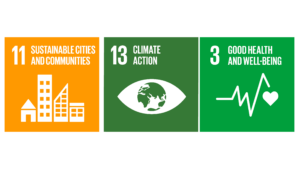Project
Heat Resistant Cities 1
How might we use Digital Twins of cities to better understand the effects of climate change, so that decision makers can act towards making cities heat resilient?
Our research questions:
- How can we validate and enhance the existing heating/cooling models with new data sources?
- How can we integrate available data sources to model the nighttime heat more accurately?
- How can we create models that are more easily interpreted and discussed by multiple stakeholders? (Municipalities, businesses, citizens)
- What effects of the built environment (dense urban living areas) need to be better understood with the new data/models?
- How can we achieve public participation and engagement to the effects of climate change on the ongoing rise of temperatures within cities?
This project is not merely a data-driven simulation of cities, but a depiction of the environment of the future where we and next generations will live in. By considering various actors involved in urban development, this case-study can serve as a showcase to discuss the future that we want to create. Data stacking and storytelling are not just tools for analysis and gathering public participation, but a validation that, we “The Present” wants “The Future” content and livable.
The Problem
In recent years more extreme weather events took place, such as drought, floods and heat waves due to climate change. Heat waves in particular affect cities the most, due to the large amount of man-made materials and constructions, such as high-rise buildings, paved paths and roads.
![]()
Through these constructions and limited cool spaces and greenery, the urban area gets immensely hot as compared to surrounding areas. This is called the “Urban Heat Island effect“. Citizens dwelling in cities are often at risk and juggle with their comfort during heat waves.
The health risks associated with night-time heat
There is a misconception that heat waves only affect the temperature and well-being of the environment and citizens during daytime. Nighttime temperature is tremendously imbalanced by heat during daytime. This spike in temperature during the night greatly affects mainly the elderly and infants (whose bodies cannot cool down easily). It becomes especially problematic and discomfortable at night when the nighttime temperature does not drop below 25 degrees Celsius. Heat stress, heat stroke and intense dehydration are all occurring more often in these occasions. Overall, human health is greatly affected by extreme nighttime temperatures during heat waves.

Our Partners
Our clients for this project are TAUW, a Dutch consultancy and engineering firm (that gives environmental advice on the sustainable development of the living environment), the HvA and the municipality of Amersfoort. In collaboration with our partners, we are aiming to understand the dynamics of heat patterns during the night by making use of Tygron, a software geodesign platform that can generate a Digital Twin of a city. Through this software, we can model the heat stress in certain neighborhoods and understand its causes and come up with potential solutions to mitigate this heat.
The word ‘Digital Twin‘ has been coined by John Vickers of NASA in a 2010 Roadmap Report. In John Vickers words, a digital twin is the combination of:
- A physical product;
- A digital or virtual product;
- A connection between these two products.
As stated by IBM Technologies a digital twin is ‘A virtual representation of an object or system that spans its lifecycle, is updated from real-time data, and uses simulation, machine learning and reasoning to help decision-making‘.
For the purposes of our project, a Digital Twin of Amersfoort has been created by using the software of Tygron. Tygron uses High Performance Supercomputing to generate 3D models of cities based on large amounts of geographical data. City designers use Tygron to critically evaluate how to make cities adaptive and resistant to extreme weather events, such as heat waves. In order to do so, different measurements can be evaluated by making use of models that can calculate the weather dynamics in the local context. Furthermore, Tygron allows the user to create its own models and aggregate new and existing data sources to their platform.
Learn more about our project
- Watch the video about our project and results in English or in Dutch
- Download our guidebook sharing the process and results of our heat stress simulation
- Read or blog post where we framing our challenge
- Read our blog post about our first exploratory results
This project focuses on the following Sustainable Development Goals (SDG’s):




